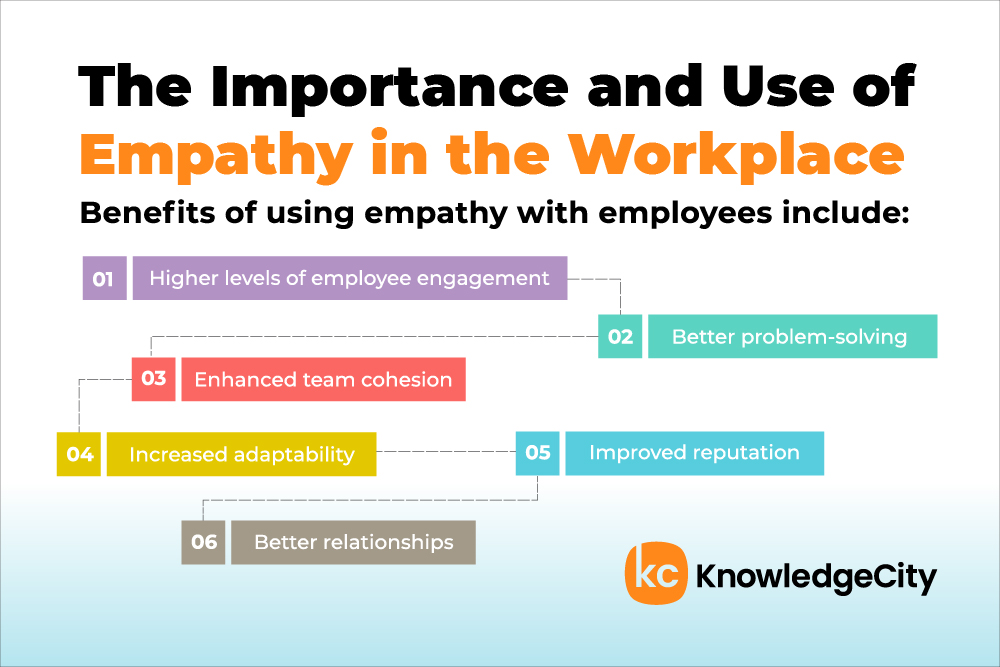What Is Empathy?
Empathy is your ability to understand others’ feelings. While empathy is practical for all relationships, it’s a key skill for the workplace. When someone shares a thought or feeling with others, the reaction they receive can establish trust and set the tone for interactions moving forward.
Let’s look at the two different types of empathy: affective and cognitive. Affective empathy is how others’ feelings impact the self. Cognitive empathy is taking on others’ viewpoints and is also referred to as perspective-taking.

With affective empathy, others’ feelings seem contagious. For example, if an employee is angry about how the company has handled an issue and shares their discontent with other employees, they may also get angry.
With cognitive empathy, someone imagines being in another person’s position. This doesn’t necessarily mean that the thought, feeling, or opinion is shared, but that it’s recognized and can be reacted to. This creates a connection with the other person.
The implications for empathy are widespread and can be used for understanding how things work, how others behave, and why and how others react the way they do.
Why Does Empathy Matter?
Empathy is often overlooked as a key leadership trait. Empathy provides the foundation for understanding and predicting behaviors during interactions. This allows employees to focus on the people they work with, which translates into more cohesive work between diverse departments and teams.
Using empathy builds and maintains trust, which provides a safe space for future interactions and increases employee morale.
Empathy Can Boost Employee Morale and Retention
Creating an empathetic workplace culture will lay the foundation for empathetic behavior among all employees. This can be done by using strategies for creating empathy among all employees. Here are a few methods for becoming more empathetic that the Society for Human Resource Management recommends:
Start with yourself. Being aware of your own empathetic practices allows you to transfer your behaviors onto employees and set the groundwork for an empathetic workplace.
Be transparent. Showing vulnerability can create a culture that allows employees to feel safe and open to sharing thoughts, feelings, and opinions.
Encourage perspective-taking. When you consider others’ viewpoints during a situation, you encourage a greater degree of communication and emotional intelligence.
Acknowledge difficult situations. Not addressing situations, especially difficult ones, can create a culture of secrecy and exacerbate conflict. Addressing those situations head-on will increase employees’ desire to work together. Their voices will be more likely to be heard and understood.
Cultivate compassion. Allowing space for employees to be kind to one another is the basis for empathy. Kindness and respect can lead to understanding and acceptance, especially in high-stakes situations.
Be realistic. Everyone learns and grows at their own pace. Say you push for a culture of empathy when it hasn’t existed before. That may not be as effective as introducing ways for employees to build relationships and trust each other before feeling comfortable using empathy.
Model agility. It’s important for everyone to be involved in a culture of empathy. Often, employees take their cues from top leadership before it becomes ingrained in company culture.
Seek out and listen to others’ viewpoints. This means all viewpoints, including ones that are unpopular or aren’t heard often.
Be open to feedback. Constantly assessing how the team, department, or organization is doing with empathy will ensure that efforts don’t lessen over time.
Reward empathy. Providing accolades for positive behavior can keep it going. It’s important to be cautious of individual motivators. For example, an employee who doesn’t like attention wouldn’t consider acknowledging their accomplishments at a large company meeting to be an award. Knowing employees is key to rewarding them properly.
How Can You Use Empathy in Conversations?
Empathetic communication is when someone can tell that their thoughts, feelings, or opinions are being listened to and understood.
Becoming an empathetic communicator doesn’t have to be difficult. There are many different strategies for communicating with empathy, including the following methods:
Show understanding. One of the easiest ways to do this is using non-verbal confirmation. Nodding one’s head or mirroring the other person’s expression confirms that the information is being received and processed.
Another way to show understanding is by summarizing what was shared. This shows the person sharing the information that what they’re saying was heard and allows them to make any necessary clarifications.
Ask for help with understanding. If the listener doesn’t understand what’s being communicated, it’s necessary to ask for more information. That way, both people are on the same page.
Share an observation. When the listener shares an observation, it should be non-accusatory and factual. For example, saying, “You purposefully ignored my request,” is accusatory and can spark defensive emotions and escalate the conflict.
Instead, say, “When I asked for help, you walked away.” In this case, you’re sharing a factual observation, ideally without emotion. This allows the other person a chance to provide clarity about the situation.
Listen. Using effective listening involves not only hearing what someone is saying but also considering their body language, facial expressions, and tone of voice. Looking at the big picture of what’s being communicated provides useful insight into what that person is thinking and feeling.
Acknowledge. Using phrases like “I understand the situation” or “I recognize the difficulty here” shows the person that what they’ve said is valid and has been heard.
Care. Going beyond acknowledgment and expressing your own feelings and emotions provides a foundation to build relationships and trust. Saying “I care” creates common ground and is the point where empathy becomes apparent.
Act. Providing solutions and helping move those solutions into results is the final way to show empathy during communication. It shows that the person was heard, understood, and what they’ve said matters enough to initiate a move forward.
The workplace benefits of communicating with empathy are significant. When conversations establish that someone is being seen, heard, validated, and understood, they also build relationships and trust. This creates honest, open conversations.
Additional benefits of using empathy with employees include:
- Higher levels of employee engagement
- Better problem-solving
- Enhanced team cohesion
- Increased adaptability
- Improved reputation
- Better relationships
When empathy is used in the workplace, situations are better understood from various perspectives. Other beliefs, experiences, and viewpoints are considered, which improves understanding and creates an environment based on trust.
Subscribe to Our Newsletter
Join 80,000+ Fellow HR Professionals. Get expert recruiting and training tips straight
to your inbox, and become a better HR manager.

 Erin Shankie
Erin Shankie 


